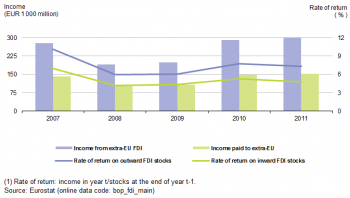Archive:Foreign direct investment statistics
- Data from June 2013. Most recent data: Further Eurostat information, Main tables and Database.
This article gives an overview of foreign direct investment (FDI) statistics for the European Union (EU) in relation to year-end stocks, annual flows and income. The analysis mainly covers the period 2009 to 2011, but provisional data on FDI flows for 2012 are also included; note that the latter are based on provisional quarterly figures that have been annualised for the purpose of this analysis.
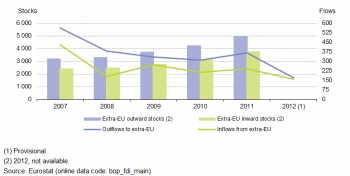
(EUR 1 000 million)
Source: Eurostat (bop_fdi_main)
Main statistical findings
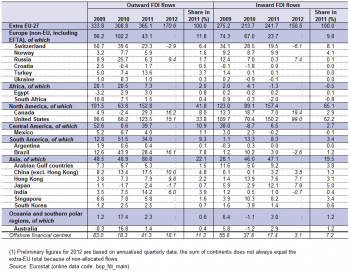
(EUR 1 000 million)
Source: Eurostat (bop_fdi_main)
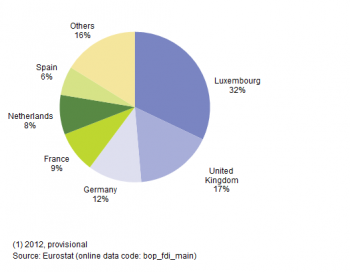
(% of extra EU-27 outward flows)
Source: Eurostat (bop_fdi_main)
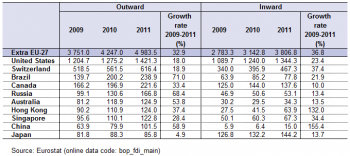
(EUR 1 000 million)
Source: Eurostat (bop_fdi_main)

(EUR 1 000 million)
Source: Eurostat (bop_fdi_pos_r2)
EU foreign direct investment (FDI) is still affected by the global economic and financial turmoil. In 2012, EU outward flows declined sharply, down 53 % compared with 2011, and recorded their lowest level since 2004. Similarly, EU inward flows decreased from the previous year — down 34 %, to the lowest level since 2005. In this way, 2012 EU FDI flows stood at more than 60 % below the record peaks of 2007 in both inward and outward investment relations with the rest of the world.
In 2010, total FDI outflows decreased by 8 %, mainly due to a sharp decline in 'equity capital', though partially compensated by an increase in 'reinvested earnings'. In 2011, they recovered slightly, up 18 %, again due to recovery in equity capital invested outside the EU.
EU inward flows declined in 2010 by 22 % but recovered partially in 2011, up 13 %. 'Other capital' contributed the most to the positive change, together with reinvested earnings.
The income return from both EU outward and inward investment in 2011 was slightly down from the previous year but remained above the levels of 2008-2009. Provisional figures for 2012 show that EU investment vis-à-vis the rest of the world decreased, partially confirming the lasting impact of the global economic crisis. As in earlier years, FDI flows channelled through Special Purpose Entities (SPE)[1] played a very significant role in the results for 2012.
FDI flows return to decline in 2012
In 2009-2011 EU FDI flows were still affected by the global economic and financial crisis. In 2011, both outward and inward flows showed signs of recovery. After the slight decrease in 2010, the EU investment abroad grew mainly due to the improved FDI activity with some traditional partners — the United States (up 87 % to EUR 123.5 billion) and Canada (moving from disinvestment in 2010 to investment of EUR 29.3 billion in 2011). The Central American countries (EUR 39.7 billion) also contributed to the positive change mainly due to the increased EU FDI activities with Offshore Financial Centres (OFC) located in this area, where SPEs play an important role. In 2011, the EU invested more in Asia (EUR 80.8 billion) but not only in its main partner countries.
The USA remained the most important player also in the EU incoming investments in 2011. The US flows (EUR 150.2 billion) into the EU doubled from the previous year to account for almost two thirds of total EU inward FDI in 2011. In fact, this compensated the shrunk investment from other traditional EU partners like Switzerland, Canada, Brazil and the OFC. The Asian investors retained their FDI in the EU at the level of the previous year.
Provisional figures for 2012 show a big downturn in the EU flows in both directions. Many large partners were strongly involved in this development.
The EU investment into the USA shrank eight-fold from the preceding year, while outward FDI in Switzerland and Japan dropped into disinvestment. The EU flows in Canada, Brazil, India and OFC halved in 2011. A slight increase in the EU investment activity was registered in Russia (EUR 9.4 billion) and Hong Kong (EUR 9.8 billion).
The US investment into the EU was down 34 % in 2012 but still remained the main source of incoming FDI. The inward flows from the OFC also marked a sharp decline in 2012, while Switzerland, Brazil and India recorded disinvestment in the EU that year. After the 2011 sharp drop, the FDI from Russia and Canada returned back to their 2009 levels.
Whereas the EU overall investment activity with the other economies in South-East Asia have been less affected by the crisis during 2009-2011, there is no indication of a recovery in 2012.
The EU FDI with Australia remains very volatile throughout the studied period. In 2011, this partner attracted only 0.4 % (EUR 1.4 billion) of EU total FDI abroad and represented 1.2 % (EUR 2.9 billion) of total EU inward flows.
EU’s main sources of outgoing FDI
FDI flows can vary considerably from one year to another, influenced mainly by large mergers and acquisitions. In 2010-2012, Luxembourg had the largest share (32 %) of EU FDI outward flows because Special-purpose entities (SPEs)[1] handle most of Luxembourg’s total direct investment. SPEs also play an important role in other EU Member States, especially the Netherlands, Austria, Hungary and Cyprus, but the data presented here exclude SPEs from these countries.
Luxembourg's outgoing FDI halved in 2012 compared with 2011, though Luxembourg remained the leading EU investor in non-EU countries. The OFC were the top destination of FDI from Luxembourg, showing the importance of the financial sector for this country. Unlike previous years, the USA and Switzerland were not among the three top receivers of Luxembourgish FDI in 2012.
In 2012, the United Kingdom recorded a sharp drop in FDI in its traditional partner, the United States, though its investment increased in Canada, Switzerland and the OFC.
FDI stocks with accelerated growth in 2011
EU outward and inward stocks (or positions) grew steadily in 2011: outward stocks by 17 % and inward stocks by 21 % compared with 13 % each direction in 2010.
EU outward FDI stocks
North America continues to hold the biggest share of non-EU countries’ stocks
At the end of 2011, North America had the biggest share (33 %) of EU stocks abroad. The United States accounted for some 29 % (EUR 1421.3 billion) of total EU outward stocks, with higher growth rate (11.5 %) compared to the previous year. The main EU holders of FDI stocks in the US were the United Kingdom (18 %), France and Germany (both 13 %).
Switzerland was by far the second most important destination for EU FDI positions in 2011, accounting for 12 % of total stocks, the main activity sector being financial intermediation. Brazil was the third main destination with a 5 % share overtaking Canada in the recent reference years, and confirming the increasing interest of EU investors in this country.
In Asia, the main holders of EU stocks were Hong Kong, Singapore and China, together accounting for half of the EU positions in Asia in 2011. Japan (EUR 85.8 billion) lost its position among the three top Asian partners of the EU but still remained ahead of India, South Korea and Indonesia.
In Africa, the main destinations for EU stocks were South Africa (EUR 79.5 billion), Nigeria (EUR 32.4 billion) and Egypt (EUR 25.8 billion). EU positions' growth in South Africa slowed down to 5 % in 2011 thus moving the country out from the group of the EU’s top ten FDI stocks partners.
Inward FDI stocks
At the end of 2011, the United States held 35 % (EUR 1344.3 billion) of total EU inward stocks from the rest of the world. The USA thus consolidated its position as the major stocks holder in the EU, having invested, as of end 2010, mostly in the financial services sector, followed by manufacturing, one third of the latter being in production of computer, electronic and optical products.
Similar to outward positions, Switzerland was the second biggest stock holder in the EU, with EUR 467.3 billion — 18 % more than in 2010.
Other countries with significant shares in EU inward positions were Japan and Canada – 4 % each, followed by Brazil, Singapore, Hong Kong and Russia. In 2011, the highest annual growth among these partners was achieved by Hong Kong (54 %) and Singapore (12 %). China's stocks in the EU grew almost three-fold in 2011 but the country was still not among the top ten investors in the EU.
Continued dominance of financial services
The activity-sector structure of EU-27 FDI stocks remained relatively steady in 2010. The EU had a positive FDI balance vis-à-vis the rest of the world in all major sectors.
Services made by far the largest contribution to both outward (59 %) and inward (57 %) stocks, and the respective shares in 2010 were slightly greater than in 2009. Almost two thirds of services stocks were held in financial and insurance activities, which themselves grew moderately from 2009. Almost all services sub-sectors contributed to the positive development, the highest growth being recorded in Information and communication. On the other hand, the EU stocks decreased in Trade (including repairs of motor vehicles) and Transportation and storage – inward stocks, and Accommodation and food service activities – both directions.
EU-27 stocks in manufacturing grew in 2010 both outward (20 %) and inward (31 %), thanks to steady increase in its main sub-sectors.
Construction and Mining and quarrying sectors' contributions to total EU stocks remained relatively unchanged from the previous year.
EU net income decreased moderately in 2011
Following the 2010 recovery, the slowdown in FDI income growth in 2011 brought rates of return[2] down to 7.3 % for outward and 4.8 % for inward stocks.
The EU’s investment income from and to non-EU countries both increased in 2011 to the record values of EUR 312.1 billion and EUR 151.7 billion, respectively. The resulting net income from the rest of the world also peaked to register a 12 % growth over the previous highest level of 2010.
The EU’s FDI income balance in 2011 was 1.27 % of EU GDP, compared with 1.17 % in 2010.
Data sources and availability
Foreign direct investment statistics in the EU are collected in accordance with Regulation (EC) No 184/2005 of the European Parliament and of the Council on Community statistics concerning balance of payments, international trade in services and foreign direct investment.
The methodological framework used is that of the OECD benchmark definition of foreign direct investment - third edition, which provides a detailed operational definition that is fully consistent with the IMF’s balance of payments manual (fifth edition).
This article is based on FDI data that were available in Eurostat’s database at the beginning of June 2013. The series in the database cover the period from 1992-2011, analysed by partner, activity and type of investment (equity capital, loans and reinvested earnings). More aggregated FDI figures that are presented in this article for 2012 are provisional results based on annualised quarterly balance of payments data.
EU-27 aggregates include special-purpose entities (SPEs), which are a particular class of enterprises (often empty shells or holding companies) not included in all countries’ national statistics. Consequently, EU-27 aggregates are not simply the sum of national figures.
Context
In a world of increasing globalisation, where political, economic and technological barriers are rapidly disappearing, the ability of a country to participate in global activity is an important indicator of its performance and competitiveness. In order to remain competitive, modern-day business relationships extend well beyond the traditional foreign exchange of goods and services, as witnessed by the increasing reliance of enterprises on mergers, partnerships, joint ventures, licensing agreements, and other forms of business cooperation.
FDI may be seen as an alternative economic strategy, adopted by those enterprises that invest to establish a new plant/office, or alternatively, purchase existing assets of a foreign enterprise. These enterprises seek to complement or substitute external trade, by producing (and often selling) goods and services in countries other than where the enterprise was first established.
There are two kinds of FDI: namely, the creation of productive assets by foreigners, or the purchase of existing assets by foreigners (for example, through acquisitions, mergers, takeovers). FDI differs from portfolio investments because it is made with the purpose of having control, or an effective voice, in the management of the enterprise concerned and a lasting interest in the enterprise. Direct investment not only includes the initial acquisition of equity capital, but also subsequent capital transactions between the foreign investor and domestic and affiliated enterprises.
Conventional trade is less important for services than for goods. While trade in services has been growing, the share of services in total intra-EU trade has changed little during the last decade. However, FDI is expanding more rapidly for services than for goods, and is increasing at a more rapid pace than conventional trade in services. As a result, the share of services in total FDI flows and positions has increased substantially, as the service sector has become increasingly international.
Further Eurostat information
Publications
Main tables
- European Union direct investments (t_bop_fdi)
Database
- European Union direct investments (bop_fdi)
Methodology / Metadata
- European Union direct investments (ESMS metadata file - bop_fdi_esms)
Source data for tables and figures (MS Excel)
Other information
External links
- OECD Benchmark Definition of Foreign Direct Investment
- United Nations Conference on Trade and Development (UNCTAD) - FDI Statistics
See also
- Africa-EU - economic indicators, trade and investment
- Balance of payment statistics
- Foreign affiliates statistics - FATS
- Global value chains - international sourcing to China and India
- Latin America-EU - economic indicators, trade and investment
Notes
- ↑ Special-purpose entities are mainly financial holding companies, foreign-owned, and principally engaged in cross-border financial transactions, with little or no activity in the Member State of residence.
- ↑ The FDI rate of return is measured here as (FDI income of year t) / (stock of FDI at the end of year t-1).

